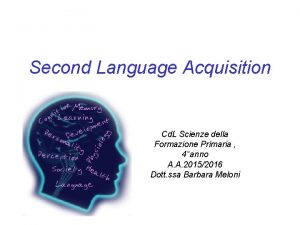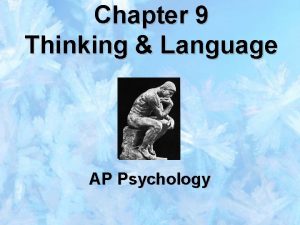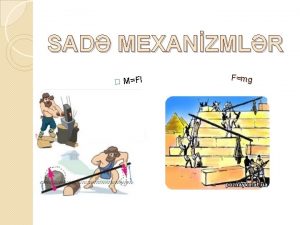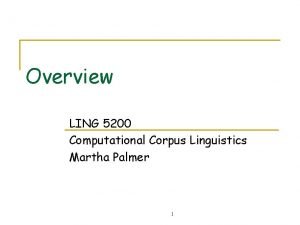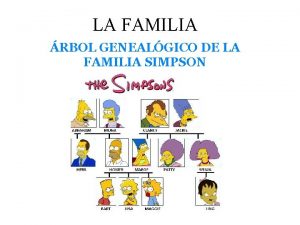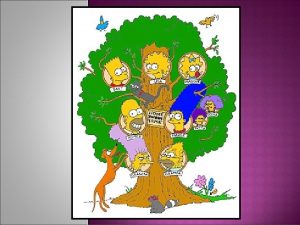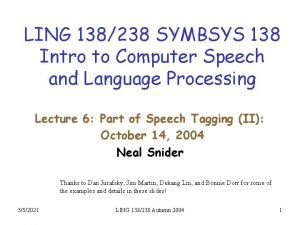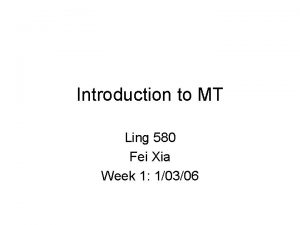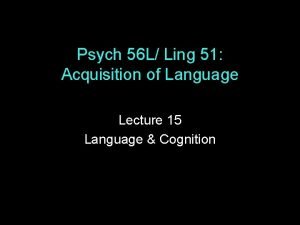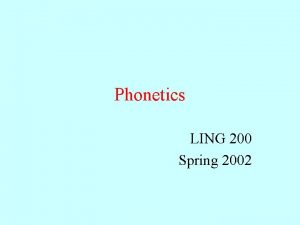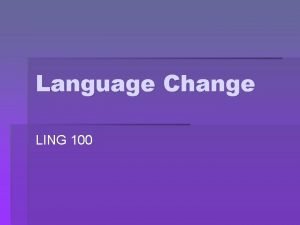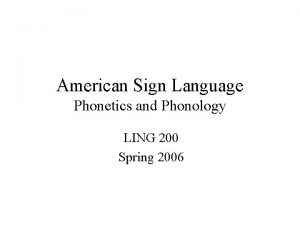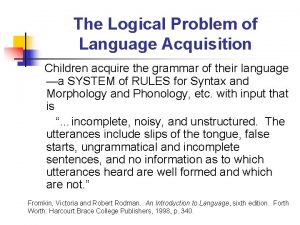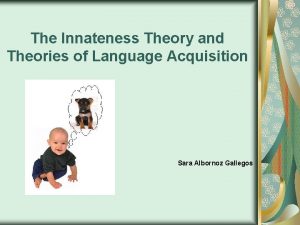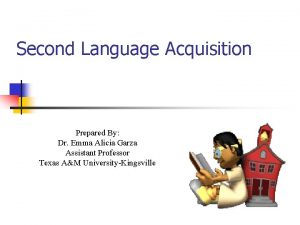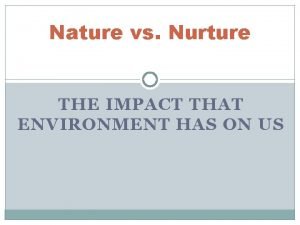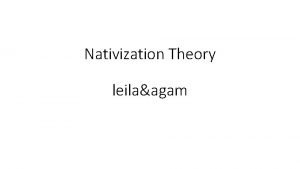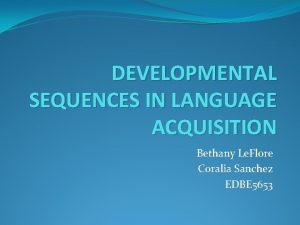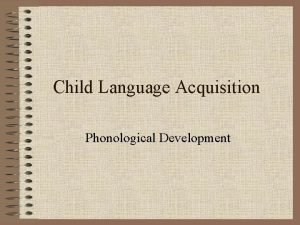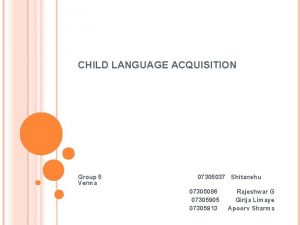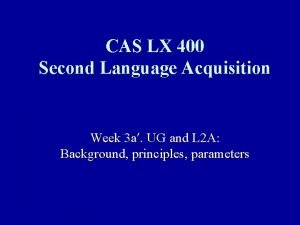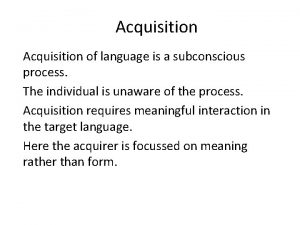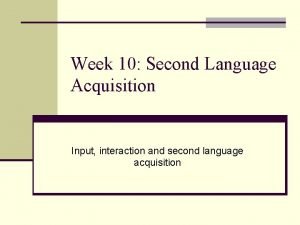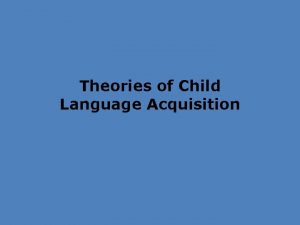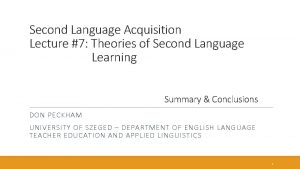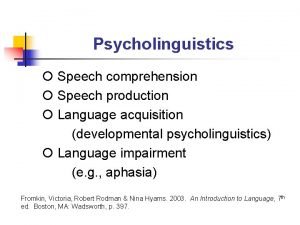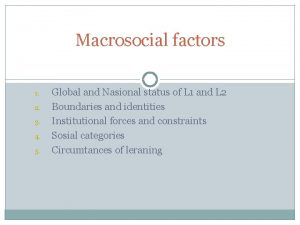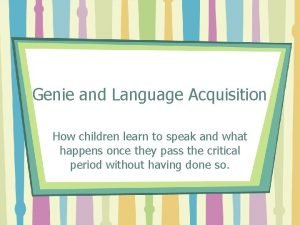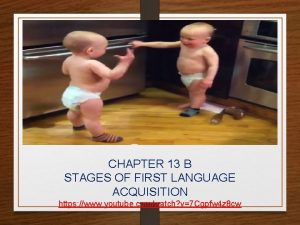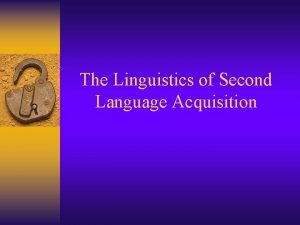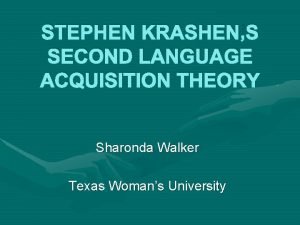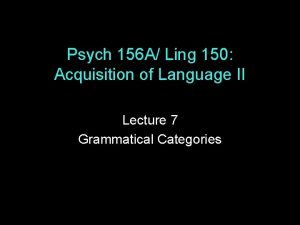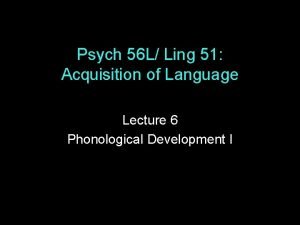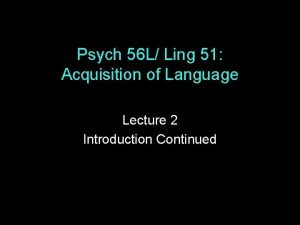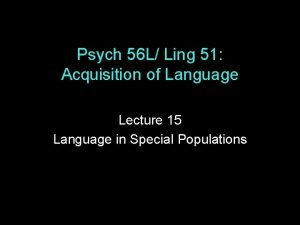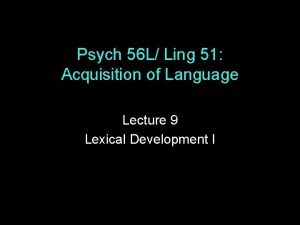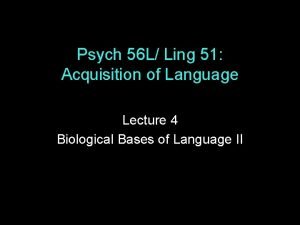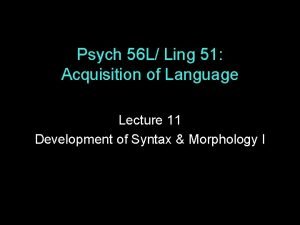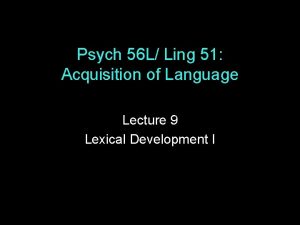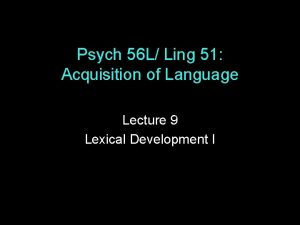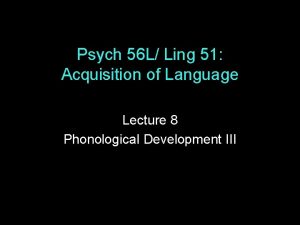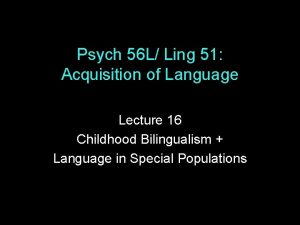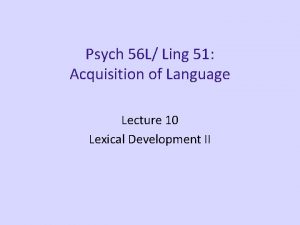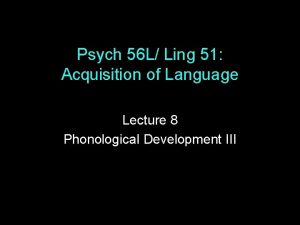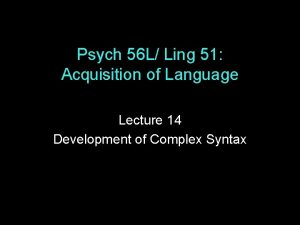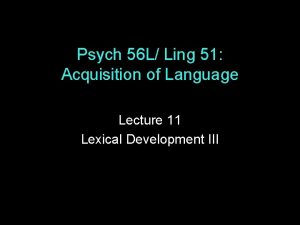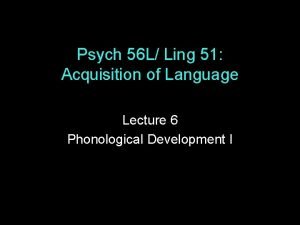Psych 56 L Ling 51 Acquisition of Language
































































- Slides: 64

Psych 56 L/ Ling 51: Acquisition of Language Lecture 15 Language & Cognition

Announcements HW 2 returned today Review questions available for language and cognition No class this Thursday (3/3/11)!

Sapir Whorf Hypothesis The structure of one’s language influences the manner in which one perceives and understands the world. “Don’t you see that the whole aim of Newspeak is to narrow the range of thought? In the end, we shall make thought crime literally impossible, because there will be no words in which to express it…” - George Orwell, 1984

“Neo”-Whorfian Question Language as a Toolkit: Does language augment our capacity for reasoning and representation (and thereby determine our perception of the world)? Also sometimes referred to as “language as augmenter” (Wolff & Holmes (2010))

What the language toolkit can do Language is a symbolic system that can help with cognitive off-loading.

Cognitive Off-Loading example (from Watson & Holmes (2010)) “This problem could be solved by mental simulation; that is, by imagining the first gear turning to the right, then the second gear turning to the left, and so on. Alternatively, people might notice that each successive gear turns in the opposite direction from the previous one and generate the parity rule that ‘odd and even gears turn in different directions’. This rule, which may depend on linguistic coding, can then be applied more quickly than the laborious process of mentally rotating each gear. ”

Language as a Toolkit Navigation (combining core knowledge system information) geometric & landmark information Number (combining core knowledge system information) small, exact numbers & large, approximate numbers Theory of Mind (realizing that someone can have a different point of view than you - when does this realization come, and how? )

Navigation Geometric “At the northeast corner” Object Landmark “At the cylinder” *rats *human infants *adult humans Combination “Northeast of the cylinder” *adult humans ONLY

Navigation Can find it here. Can’t find it here by combining cues.

But can toddlers really not do it? Maybe wall color just isn’t a very salient property for toddlers. How about trying more salient landmarks? (Hermer & Spelke 1996)

But can toddlers really not do it? Maybe wall color just isn’t a very salient property for toddlers. How about trying more salient landmarks? (Hermer & Spelke, 1996) No change in navigation behavior in toddlers even with more salient landmarks (toys like truck and teddy bear).

So when does this ability develop? Hermer-Vazquez, Moffet & Munkholm (2001): children with a high production of spatial language (like “left” and “right”) succeed. This usually happens somewhere between 4 and 5 years old. Implication: Spatial language use seems integral in solving this task that requires representing information from different domains (geometry & color). However… rats (who don’t have spatial language) can be trained to do the same thing after hundreds of trials. Spatial language is useful, but not necessary?

Is language really responsible? Hermer-Vazquez, Spelke & Katnelson (1999) Testing adults, who were asked to verbally shadow as they performed the task. Verbal shadowing (language as meddler: Watson & Holmes (2010)) = repeating as fast as they could a passage recorded on tape. Interferes with linguistic combination abilities. [Class demo of verbal shadowing] X

Is language really responsible? Hermer-Vazquez, Spelke & Katnelson (1999) Verbal-shadowing adults behaved just like toddlers! They searched equally the correct corner and the rotationally equivalent one, seemingly unable to combine the information from geometry and color. X

Is language really responsible? Hermer-Vazquez, Spelke & Katnelson (1999) Experiments with adults who were doing nonverbal shadowing (repeating a rhythm by clapping) did not show this result, despite the fact that the nonverbal shadowing (rhythm shadowing in this case) is as cognitively taxing as verbal shadowing. [Class demo of rhythm shadowing] X

Is language really necessary? Gouteux, Thinus-Blanc, & Vauclair (2001): testing Rhesus monkeys (who do not have spatial language) Tested 3 monkeys on location “left of wall opposite the blue wall”. ~50 trials each. Two monkeys: ~85% correct Other monkey: ~70% correct Pretty good for no spatial language! X

Is language really necessary? So language does seem to play a very important role in the ability to combine information from different core knowledge systems. (Perhaps not absolutely necessary, but extraordinarily helpful - kind of like motherese for language development. ) Or maybe rhesus monkeys are just clever enough to do this without the spatial language that humans seem to rely on. Maybe humans rely on language because they have it as a tool at their disposal…

Number Core number systems shared by humans and other animals: System for representing approximate numerical magnitudes (large, approximate number sense) System for representing persistent, numerically distinct individuals (small, exact number sense)

Decide Fast: How Many?






Decide Fast: Which side has more?





How We Deal With Number Amount Being Represented How Represented Very small numbers “Subitizing”- up to 4; can tell what set looks like at a glance Large approximate numerosities System for representing approximate numerical magnitudes (adults at a glance can tell apart groups with a ratio of about 1. 1 to 1) Large exact numerosities Combo of 2 above systems plus language

What human language does… Many languages have an exact number system that provides names for exact quantities of any size 1, 2, 3, 4, 5……. 578, 579, 580, 581, 582… This bridges the “gap” between the two core systems. Supporting evidence from Dehaene, Spelke, Pinel, Stanescu, and Tsivkin. (1999): f. MRI study showed that the exact number task recruited neural networks typically associated with language processing. Another test of this: Look at numerical cognition of people whose languages don’t have an exact number system.

Languages without Exact Number Systems Pica, Lemer, Izard & Dehaene (2004): Munduruku speakers in Brazil who only have exact numbers for 1 -5. When doing simple tasks like addition and subtraction with numbers outside this range (ex: 8 -6), they do much worse than speakers who have an exact number system (though still better than chance). Gordon (2004): Pirahã speakers in Brazil who only have words for “one/two” and “many”. Exact arithmetic on larger numbers that are both outside the small, exact system and outside the language is very, very hard to do.

Gelman & Gallistel (2004) “Language and the Origin of Numerical Concepts” “Reports of subjects who appear indifferent to exact numerical quality even for small numbers, and who also do not count verbally, add weight to the idea that learning a communicable number notation with exact numerical reference may play a role in the emergence of a fully formed conception of number. ” No language for large exact numbers = no representation for large exact numbers

Children’s numerical cognition • English children must learn number words, and it can take them a surprisingly long time to do it. • Even if children can recite a list of counting numbers (“one, two, three, four, five, …”), they may not necessarily understand that “three” refers to the quantity three. • Moreover, even if they recite the list when seeming to count objects, they do not realize that the last number they say is the right answer. Investigator: “How many are there? ” Child: “One, two, three, four, five. There are three!” Barbara Sarnecka

Children’s numerical cognition • The process of connecting number words to quantity seems to occur in stages: Pre-number-knowers: no number word knowledge One-knowers: “one”, but no other numbers Two-knowers: “one”, “two”, but no others Three-knowers: “one”, “two”, “three”, but no others Cardinal-principle-knowers: children realize the connection between the counting list and quantity (cardinal principle of counting) – the last number you say is in the list is the quantity (denotes the cardinality of the set) Barbara Sarnecka

Children’s numerical cognition Negen & Sarnecka (2010): Tested children’s non-verbal numerical cognition when they did not necessarily know the exact meaning of number words. “Now we’re going to play a copying game. I will give something to the anteater…(experimenter puts some items from a bowl onto his plate, and slides it to his stuffed animal)…and you give something to the bunny. You copy me and make your plate look just like mine. ” “Now we’re going to play a remembering game. I will give something to the bunny…(experimenter demonstrates)…and you try to remember what I gave the bunny. (Experimenter returns items to the bowl. ) You give the bunny something and try to make yours just like mine was. ”

Children’s numerical cognition Negen & Sarnecka (2010): Tested children’s non-verbal numerical cognition when they did not necessarily know the exact meaning of number words. Results: Children who know more number words did a better job at replicating and remembering the number of items. Surprisingly, performance improved for all number sizes, even the ones children didn’t necessarily have words for yet. Example: Child knows “one” and “two”, but improves at replicating/remembering not only one and two, but also three, four, and five objects. Language for numbers helps improve non-verbal comprehension and memory for numbers.

Language as a Toolkit: Theory of Mind

Sarah thought that Hoggle had betrayed her. The embedded sentence encodes the contents of Sarah’s mind. The ‘truth value’ of the embedded sentence cannot be evaluated with respect to this world. It must be evaluated with respect to Sarah’s mental world (what Sarah thinks). What if a child didn’t know this?

What You Need to Know To Evaluate the Truth Value of These Statements Syntactic Knowledge: you know that some verbs can take sentential complements (think, believe, say, …) Social Cognitive Knowledge: you know that other people can have a false belief Bridge: you know that there is a connection between this syntactic form and the expression of potentially false beliefs Which comes first, social or syntactic knowledge? Usual Pattern: Social/Conceptual ---> Linguistic Whorfian: Linguistic ---> Social/Conceptual

A Leeetle Problem… How do you measure children’s understanding that other people can have false beliefs? (abstracted away from their linguistic ability to represent false beliefs)

False Belief Task The child is introduced to two puppets, Sir Didymus and Ambrosius. Sir Didymus Ambrosius

False Belief Task While playing, Sir Didymus puts a marble into a bin and then goes outside (the puppet disappears under the table, for example). marble bin

False Belief Task While playing, Sir Didymus puts a marble into a bin and then goes outside (the puppet disappears under the table, for example).

False Belief Task When Sir Didymus is not around, naughty Ambrosius changes the location of the marble. He takes it out of the bin and puts it in a different bin.

False Belief Task Some time later Sir Didymus comes back and wants to play with his marble. Children are then asked the critical question: Where will Sir Didymus look for his marble?

False Belief Task Some time later Sir Didymus comes back and wants to play with his marble. Children are then asked the critical question: Where will Sir Didymus look for his marble? 4 to 5 -year olds Correct 3 -year olds & autistic children Incorrect

If we’re looking for a language connection… At what age do children start talking about thoughts/beliefs? At what age do children first begin to use sentential complements? 2 -year-olds talk a lot!. . . about what they did, what they want. . . about what others do. . . possibly about what others say – not about what others think

If we’re looking for a language connection… At what age do children start talking about thoughts/beliefs? At what age do children first begin to use sentential complements? Children’s comprehension of sentential complements “Sir Didymus said he bought peaches. But look! He really bought oranges. What did Sir Didymus say he bought? ” 3 -year-olds: oranges (reality, not mental state) 4 -year-olds: peaches (key into “say that”)

If we’re looking for a language connection… At what age do children start talking about thoughts/beliefs? At what age do children first begin to use sentential complements? At around four years of age, children understand that mental verbs can take a whole sentence as their object (a complement) Sir Didymus thought that the shampoo was the toothpaste. And the embedded sentence can be FALSE from the child’s Point of View, but TRUE for Sir Didymus. Once the child has this capacity, he can represent two worlds: his own, and someone else’s mental world. This usually coincides with children’s production of mental state verbs.

Testing typically developing children De Villiers & Pyers (2002): Measures of comprehension and production of sentential complements far more correlated with children’s performance on false belief tasks than any other linguistic measure. Causation? “In every case, children who passed false beliefs gave us evidence that they had productive command of complementation. ” Learning Trajectory: Easier to observe what people say than what they think. Can get more helpful data with communication verbs that take sentential complements (like say), and then extend that by analogy to mental verbs like think.

Testing the Connection in Other Ways and in Other Populations What if you train children on communication verbs that take sentential complements? Do they improve on false belief tasks? Test development in deaf children who are language-delayed vs. not

Training children on communication verbs Hale & Tager-Flusberg (2003): Children who were trained on sentential complements (“say that…”) did well on both sentential complement tests and false belief tasks. However, children trained only on false belief tasks also did well on false belief tasks. Familiar implication: Sentential complements not required, just extraordinarily helpful.

Testing deaf children (delayed v. s non-delayed language) de Villiers & de Villiers (2003): Oral deaf children (who are language-delayed) with normal IQ and active social intelligence are significantly delayed in false belief tasks. Performance on both verbal and non-verbal false belief tasks are delayed to the same degree. Best predicted by sentential complement production with verbs of communication or mental state, not just by general language ability. Implication: Language (specifically sentential complements) required for success on false belief tasks. (Maybe no one trained them explicitly on false belief tasks? )

Testing deaf children (delayed vs. non-delayed language) Pyers & Senghas (2009): Tested two groups of learners of Nicaraguan Sign Language (NSL). Group 1 (older): Learned an early form of NSL Group 2 (younger): Learned a later form of NSL Main difference: Group 2 knew many more signs for mental state verbs like think and know than Group 1 Results: Group 2 did much better on false belief tasks than Group 1, despite being younger. Implication: Language (specifically mental state verbs that take sentential complements) required for success on false belief tasks. (Maybe no one trained them explicitly on false belief tasks? )

So what is it about language? Perner, Stummer, Sprung, & Doherty (2002): Ability to simultaneously consider multiple names for a single object (Name-Name task) is strongly correlated with performance on False Belief tasks. Name/Name (Synonym) Man/Guy

So what is it about language? What do sentential complements and multiple names for a single object have in common? Both require the ability to represent an object or event from multiple perspectives simultaneously “Our claim is that the ability to confront different perspectives emerges around 4 years and underlies the co-emergence of success on the False Belief and the Name-Name tasks” Perner, Stummer, Sprung, & Doherty (2002)

Theory of Mind: Link to Language is…? Additional evidence from Baillargeon, Scott, & He (2010): 2 -year-olds can pass a false belief task when they are tested indirectly. How do we test them indirectly? We can gauge their spontaneous responses (as assessed by looking time) to events they are shown. Baillargeon et al. (2010) argue that this is an easier task than requiring the children to answer a question directly using language. Familiar implication: Language is extraordinarily helpful but not explicitly required.

Indirectly Testing False Belief Familiarization: In trial 1, a toy stood between a yellow and a green box; a female agent entered the apparatus, played with the toy briefly, hid it inside the green box, and then paused, with her hand inside the green box, until the trial ended. In trials 2 and 3, the agent reached inside the green box, as though to grasp her toy, and then paused.

Indirectly Testing False Belief Induction: In the belief-induction trial, the toy either moved from the green to the yellow box in the agent’s absence (false-beliefgreen condition) or moved to the yellow box in the agent’s presence but then returned to the green box after she left (false-belief-yellow condition).

Indirectly Testing False Belief Testing: In the test trial, the agent returned, reached inside either the yellow box (yellow-box event) or the green box (green-box event), and then paused. In each condition, the infants expected the agent to reach where she falsely believed the toy to be hidden, and they looked reliably longer when she reached to the other location instead.

Theory of Mind: Link to Language is…? Language is useful for cognitive off-loading? Perhaps when children are tested directly on false belief tasks (that is, required to show their knowledge with language), having mental state verbs in their linguistic repertoire allows them to easily encode what’s going on. Then, it’s easier to do the task, which requires more mental work than tasks where children are tested indirectly. But the jury is still out…

Language & Cognition: Recap Whorfianism is the belief that language influences (or determines) someone’s experiences in the world. Neowhorfianism is a variant that believes language augments thought, so we can think more complex thoughts. In several cases, we have seen evidence for cases where language seems to enable more complex thought - or at least to enable it to happen more easily.

Questions? You should be able to answer all the questions on the language & cognition review questions.
 Second language acquisition vs foreign language acquisition
Second language acquisition vs foreign language acquisition Language
Language Mental grouping of similar objects
Mental grouping of similar objects Jin ling cigarettes
Jin ling cigarettes Tərpənən blok
Tərpənən blok Ling
Ling Erin ling
Erin ling Ling oa
Ling oa Mei-ling from singapore was preparing
Mei-ling from singapore was preparing Abuela de bart simpson
Abuela de bart simpson Dr ng li ling
Dr ng li ling Nien-ling wacker
Nien-ling wacker Ling shih fu
Ling shih fu Ling simpson
Ling simpson Graph4ai
Graph4ai Who's this
Who's this Walter ling
Walter ling Ling
Ling Ling
Ling Ling
Ling Mtling
Mtling Wai ling lam
Wai ling lam Ling oa
Ling oa Wang ling relationship
Wang ling relationship Shi sheng ling
Shi sheng ling Ling rolled
Ling rolled Left ling
Left ling Negen ling
Negen ling Cheung yin ling
Cheung yin ling Wai ling lam
Wai ling lam Artyom sidorkin
Artyom sidorkin Example of short term goal
Example of short term goal Mei-ling huang
Mei-ling huang Ling 200
Ling 200 Ling internet
Ling internet Agnes ling
Agnes ling Ling 100
Ling 100 Ida ling
Ida ling Sign language phonetics
Sign language phonetics Logical problem of language acquisition
Logical problem of language acquisition Innateness theory
Innateness theory Language acquisition
Language acquisition Theories of 2nd language acquisition
Theories of 2nd language acquisition Similarities of vygotsky's piaget's and chomsky's theories
Similarities of vygotsky's piaget's and chomsky's theories Oxana malaya nature vs nurture
Oxana malaya nature vs nurture What is nativization
What is nativization Wida language objectives examples
Wida language objectives examples Language acquisition device
Language acquisition device Developmental sequence in language acquisition
Developmental sequence in language acquisition Neurological considerations in language acquisition
Neurological considerations in language acquisition Berko and brown fish
Berko and brown fish What is language acquisition device
What is language acquisition device Language
Language Krashen's 5 hypothesis
Krashen's 5 hypothesis A subconscious process in developing a language
A subconscious process in developing a language Language
Language Undergeneralization in language
Undergeneralization in language 7 theories of second language acquisition
7 theories of second language acquisition Garden path sentence
Garden path sentence Macrosocial factors in second language acquisition
Macrosocial factors in second language acquisition Genie language acquisition
Genie language acquisition Systematicity and variability
Systematicity and variability Stages of babbling
Stages of babbling роберт ладо
роберт ладо Stephen krashen language acquisition
Stephen krashen language acquisition

